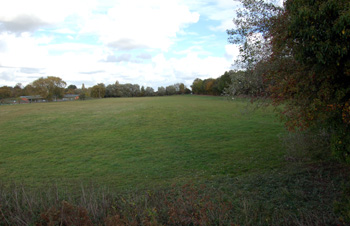Blunham Before 1086

The site of a Bronze Age Ring Ditch near Barford Bridge October 2009
The Heritage Environment Record [HER], formerly kept by Bedfordshire County Council and now separately by Central Bedfordshire, Luton Borough and Bedford Borough Councils is an invaluable tool for those wishing to study the landscape and built landscape of the county. The record is available on-line.
Palaeolithic
Two axes and two flint flakes [HER 598] from the Palaeolithic era were found in gravel pit in Blunham but unfortunately no date or exact location is known. It seems reasonable that at this time the rivers of Britain would have served as major trade and migration routes, particularly large rivers like the Great Ouse. Thus, the idea of at least semi-permanent settlements along its banks seems likely.
Mesolithic
The Mesolithic era is depicted as being that of the hunter/gatherer in which small groups moved around after game, gathering fruits and berries to supplement their diets. There are no permanent settlements and so the only trace these people leave is their artefacts, a number of which have been discovered in the parish.
An eight year old boy collected a number of prehistoric and later artefacts [HER 9772] from the area around Hunter's Lodge in Grange Road. Amongst his collection was a stone implement which may have dated to the Mesolithic or the Neolithic. A Mesolithic axe tranchet axe or adze head, about 10 centimetres long was found in Blunham at some unspecified date and in an unspecified place [HER 9838] and now lies in Bedford Museum.
Neolithic
The Neolithic, or New Stone Age is that associated with the first monuments and settlement sites still visible in the landscape. This is because the era was one in which arable farming was introduced, inducing people to stay in one place. A number of Neolithic artefacts have been found in Blunham. The implement found by the boy near Hunter's Lodge [HER 9772] has been referred to above. A Neolithic axe was also found in 1975 when Anglian Water Authority was doing work at Barford Lock. The Heritage Environment Record [HER 9816] notes: "Some "Medieval stuff" was found…The finder also reported five or six stone axe heads, which he put in a heap, but children threw into the river". A Neolithic axe head found in Blunham [HER 14782] is now in Bedford Museum. Two tanged and barbed arrowheads were also found in Blunham, though the exact site is unknown [HER 16202].
Bronze Age
The Bronze Age, as the name suggests, was the era in which metal working was gradually introduced, though stone tools continued to be used alongside them. Typical of this era are features called ring ditches - as the name suggests circular, semi-circular or oblong ditches. A number have been noted in Blunham. A group of features lies in the north of the parish, running parallel to the old line of the River Ivel to the east. These features include several ring ditches and a round barrow [HER 615]. The area also contains features from the Iron Age, and perhaps later, giving tantalising hints of a continuing settlement. Another ring ditch has been identified as a cropmark west of The Villa [HER 613]. Again, other, straight, features form part of the complex. At the same time as the axe heads were discovered at Barford Lock [HER 9816] a Bronze Age spearhead was found, reported to LutonMuseum and kept by the finder. Nearby, just south-east of BarfordBridge are traces of a further ring ditch [HER 2792].
Iron Age
The group of features extending from the Bronze Age into the Iron Age (and perhaps beyond into the Roman period) from the north of the parish has already been noted above [HER 615]. The Iron Age feature is an rectangular enclosure.
General Prehistoric Features
A number of cropmarks in the parish suggest prehistoric origins but, without associated finds, cannot be definitely dated. These include the following:
- Cropmarks of a broadly rectangular feature west of The Villa [HER 613];
- Cropmarks of small features featuring curved and straight lines, crossed by an irregular feature from the west of the parish close to Poppin Well and the River Great Ouse [HER 1842];
- Cropmarks of straight-lined features, now partly buried beneath a glasshouse at The Villa [HER 13756];
- A cropmark of an enclosure featuring curved and straight lines just west of Hanger View Farm [HER 16770].
Romano-British
A number of Roman finds have been made in Blunham. The eight year old's collection of finds from around Hunter's Lodge [HER 9772] included Romano-British pottery. Part of a Roman Quern, for grinding corn, made from Hertfordshire pudding stone was found at an unspecified date and in an unspecified place in the parish [HER 489]. Fragments of Roman pottery were found whilst engaged in dredging the River Great Ouse around Barford Bridge [HER 14656] and a Roman coin of the radiate type (probably 3rd century AD) was found on the footpath running south of Hanger View Farm and then north to Barford Road [HER 11462]. The Viatores, a group dedicated to finding Roman roads, have tentatively identified a road running from Sandy, through Mogerhanger, Blunham, Great Barford, Wilden, Renhold, Ravensden, Thurleigh, Bletsoe and Sharnbrook [HER 728], suggested by modern roads, green ways and hedgerows but much of the route must be regarded as very speculative.
Post Roman and Pre-Conquest
It seems likely that the site of the modern village of Blunham was occupied for at least part of the period 410-1066AD but finds are disappointingly scarce. A spearhead from this period was found in the schoolboy's collection from around Hunter's Lodge [HER 9772] and some sherds of Anglo-Saxon pottery have been discovered near the Bronze Age ring ditch south-east of Barford Bridge [HER 2792].